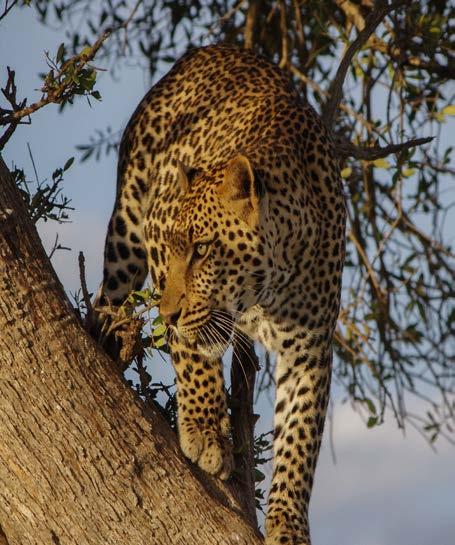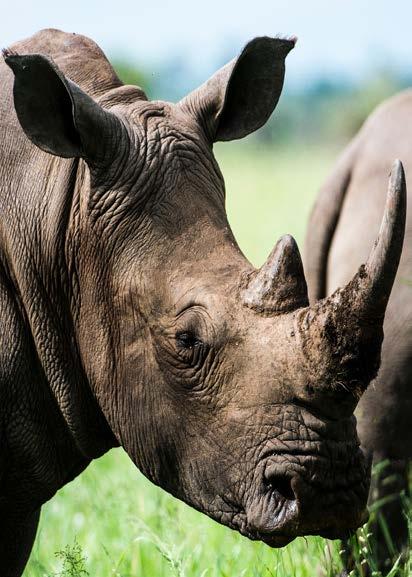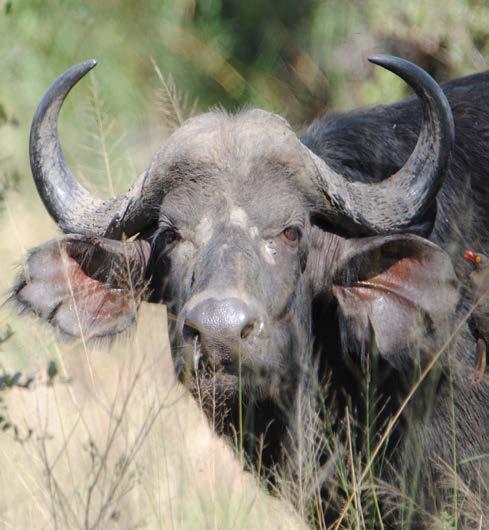
8 minute read
Africa's Big Five - what are they?
Africa’s Big Five – what are they?
Visitors to South Africa typically want to cross the Big Five off their bucket list – but what are the Big Five?
Tour operators have borrowed the term from the game hunting industry and adapted it for their own marketing efforts. Originally, the term Big Five meant the five animals that gave their hunters most difficulty because of their unpredictable behaviour. Thankfully, hunting is falling out of favour, but the Big Five tag has stuck, so let’s explore them - the lion, leopard, rhino, elephant and buffalo.

King of the grasslands - the lion Living in the grasslands, scrub and open woodlands of sub-Saharan Africa, the lion is the second largest cat in the world (behind tigers). African lions are the most social of all big cats and live together in groups or prides. Although extremely large prides, consisting of up to 30 individuals, have been seen, the average pride consists of five or six females, their cubs of both sexes, and one or two males who mate with the adult females.
Lions live for about 10-14 years in the wild. While in captivity, they live for as long as 20-25 years old. The average male lion weighs around 180kg, while the average female lion weighs around 130kg. The heaviest lion on record weighed an amazing 375kg.
Lions can reach speeds of up to 81kph, but only in short bursts because of a lack of stamina. An adult male’s roar can be heard up to 8 kilometres away.
African lions eat large animals they find in the grasslands, including antelopes, zebras and wildebeest. A female lion needs 5kg of meat a day, while a male needs 7kg or more a day.
Lions have astounding night vision. They are six times more sensitive to light than humans, which give them a distinct advantage over some prey species when hunting at night.
Lions enjoy relaxing and lazing around and can spend between 16 and 20 hours each day resting and sleeping. They have few sweat glands so they wisely tend to conserve their energy by resting during the day and become more active at night when it is cooler.
They are intelligent animals and use body language by rubbing their heads against one another to exchange scents and convey information about their intentions and feelings.
While females do all the hunting, males get to eat first even if there are cubs in the pride. Females also remain in the same pride for life and share a very strong bond with their pride.
Did you know? Lions are symbols of strength and courage. They are also common symbols for royalty and stateliness, hence the phrase ‘king of the jungle’.
An anti-social beauty – the leopard Leopards are the least social - and perhaps the most beautiful - of the African big cats. They usually keep to
themselves, lurking in dense riverine bush or around rocky outcrops, emerging to hunt late in the afternoon or at night.
The least visible of the Big-Five, the leopard is nocturnal, solitary and very secretive, keeping under cover during the day. They are also very anti-social with

antelope. Strangely, they are very good swimmers and occasionally consume fish and crabs from rivers.
Leopards are highly adaptable creatures, capable of living in semi-desert conditions as well as dense subtropical bush. Their territories can also vary in size from 10 square kilometres, to several hundred square kilometres. The animals scratch trees and use urine to mark their turf. A male will defend his territory against other males, but will share territory with females.
Leopards can survive for long periods without drinking, satisfying all their moisture needs from their prey.
Did you know? Leopards communicate with each other through distinctive calls. When a male wants to make another leopard aware of his presence, he will make a hoarse, raspy cough. They also growl when angry and, like domestic cats, purr when happy and relaxed.
each other beyond mating and raising their cubs. Male and female leopards spend only a brief time together while they are mating and then go their separate ways. The female will then raise the cubs on her own.
After the lion, the leopard is the next-biggest African cat with an average body mass of between 60kg and 70kg, standing about two-thirds of a metre tall at the shoulder. Leopards in the wild may live up to 15 years. Unlike the lion, the leopard is a silent creature, only occasionally emitting a cough-like call.
They are most often found in trees and are excellent tree climbers. They will safeguard their kill in a tree to prevent other predators from stealing it. This tree ‘lardering’ protects the carcass against scavengers and allows a few days of undisturbed feeding. Interestingly, a leopard can drag its prey, weighing up to three times more than its own body weight, up into trees over six metres tall.
These big cats eat a variety of food, from wildebeest to fish, but most of their diet comes in the form of
Endangered and ancient - the rhino The rhinoceros is the most endangered species of the Big Five. Rhinos are one of South Africa’s biggest draw cards as the country is home to the largest remaining population of these ancient animals. They are also one of the largest land mammals alive after elephants. They have existed on Earth for over 50 million years; their prehistoric features and the horns on their forehead make them easily recognisable. There are two species of rhinoceros - the white and black rhino. White rhino are not white but grey, and the name is thought to be a misinterpretation of the Afrikaans word ‘weit’ meaning wide, in reference to their square shaped mouth that helps them graze. The mouth of the Black rhino is hooked. The White rhino is a grazer and the Black rhino is a browser, hence the shapes of their mouths. There is also a difference in size with the White rhino the bigger of the two.
The rhino is a very aggressive mammal, possibly because of its poor vision - and will sometimes attack trees and rocks by accident. However, they have excellent hearing and a strong sense of smell.
Poachers are tragically responsible for the decreasing rhino population in South Africa. The horn is sold mainly in Eastern countries such as Japan where they are used in traditional medicine to cure headaches, fever and food poisoning and even snake bites. A common myth is that
rhino horn is used as an aphrodisiac, but this is not true.

Did you know? A rhino’s horn is not attached to its skull. If it breaks off, it will grow again. Rhino horn is not made up of compressed hair as once thought but rather keratin (the same material that makes nails, claws and hooves). The horn is sought after for its supposed medicinal purposes.
Massive and intelligent - the elephant The largest animal in Africa is the elephant, with herds wandering through 37 countries on the continent. Their trunk is used for communication and handling objects. And their large ears allow them to radiate excess heat. Upper incisor teeth develop into tusks in African elephants and grow throughout their lifetime. There are two subspecies of African elephants
— the Savanna (or bush) elephant, which is the larger, and the Forest elephant.
Savanna elephant family units usually consist of around 10 females and their calves, and the bulls associate with these herds only during mating. Several family units often join together to form a clan consisting of up to several hundred members led by a female matriarch. Savanna elephants are often found grazing on grasses, but they also browse on a wide variety of plants and fruits. This selection varies depending on the time of year; during the rainy season the elephant will feed more on grass than during the dry season.
They are extremely intelligent creatures and show a wide range of social behaviour, including complex communication techniques and emotional displays. The most well-known, of course, is trumpeting. Elephants trumpet to signal distress or excitement. They also make roaring sounds when charging.
Elephants use infrasonic sound for communication as well, at frequencies too low for humans to hear. These sounds are capable of travelling very large distances through the ground and are usually for signalling something to the whole herd.
Elephants also use many other touch and visual signals for communication. A mother and baby use their trunks to touch each other to communicate. Calves, for example, will touch their

mother’s teat with their trunk to indicate that they want to suckle. Mothers are known to slap calves with their trunks to discipline them. And just like human babies, some baby elephants suck their trunks.
Did you know? Elephants can get sunburnt under the scorching African sun. So, they throw sand on their backs and heads to prevent sunburn and also to keep insects off their skin. Even though they have very tough skin, they can still feel small insects walking on them.
Death’ and ‘Widow Maker’. It is said that buffalo look at you as if you owe them money, and this is an appropriate description if you should ever come across them on foot in the bush!
Moody and gregarious - the buffalo The African buffalo made its way into the Big Five ranking because of their size, moody behaviour and their ability to charge with no warning. A large and powerful bovine that has a lifespan of around 23 years, the African buffalo reaches shoulder heights of up to 1.5 metres and weighs about 750kg.
Buffalo are gregarious and live in mixed herds, often numbering hundreds of individuals. They are not territorial because they are bulk grazers and need to find suitable grazing and water continuously.
Buffalo protect their own! They are mainly preyed upon by lions but often when a herd member is attacked, others will rush to its defence. Working together, buffalo are more than capable of driving off an attack by an entire pride of lions. In some cases, they have been observed killing lions that have killed a member of their herd.
The African buffalo is very dangerous and has never been domesticated, unlike the water buffalo that has an uncanny resemblance to the African buffalo. A wounded buffalo bull is regarded as extremely dangerous by hunters and is one of the reasons why this trait is the origin of many hunting adventures, myths and legends. Buffalos are said to have killed more hunters in Africa than any other species.
Buffalo are ranked in their herds by their fighting capabilities and will often have head-on clashes to determine rank in the herd.

Where can you see the Big Five?
In South Africa you can see the Big Five at the Kruger National Park and several private reserves.
Long a stronghold of the Big 5, South Africa offers perhaps Africa’s most reliable Big Five sightings in the private reserves that border the Kruger National Park, itself a famous Big Five hotspot. The Sabi Sands Private Game Reserve is exceptional: leopards are relatively common there and the reserve generally delivers all the Big Five within a couple of days.
Private game reserves in the Eastern Cape as well as the far northern Madikwe Private Game Reserve, offer superb Big Five game viewing in a malaria-free, family-friendly environment, though it should be noted that leopards are extremely elusive in these reserves.



